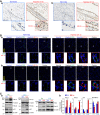Divergent changes of p53 in pulmonary arterial endothelial and smooth muscle cells involved in the development of pulmonary hypertension
- PMID: 30358436
- PMCID: PMC6383500
- DOI: 10.1152/ajplung.00538.2017
Divergent changes of p53 in pulmonary arterial endothelial and smooth muscle cells involved in the development of pulmonary hypertension
Abstract
The tumor-suppressive role of p53, a transcription factor that regulates the expression of many genes, has been linked to cell cycle arrest, apoptosis, and senescence. The noncanonical function or the pathogenic role of p53 has more recently been implicated in pulmonary vascular disease. We previously reported that rapid nuclear accumulation of hypoxia-inducible factor (HIF)-1α in pulmonary arterial smooth muscle cells (PASMCs) upregulates transient receptor potential channels and enhances Ca2+ entry to increase cytosolic Ca2+ concentration ([Ca2+]cyt). Also, we observed differences in HIF-1α/2α expression in PASMCs and pulmonary arterial endothelial cells (PAECs). Here we report that p53 is increased in PAECs, but decreased in PASMCs, isolated from mice with hypoxia-induced pulmonary hypertension (PH) and rats with monocrotaline (MCT)-induced PH (MCT-PH). The increased p53 in PAECs from rats with MCT-PH is associated with an increased ratio of Bax/Bcl-2, while the decreased p53 in PASMCs is associated with an increased HIF-1α. Furthermore, p53 is downregulated in PASMCs isolated from patients with idiopathic pulmonary arterial hypertension compared with PASMCs from normal subjects. Overexpression of p53 in normal PASMCs inhibits store-operated Ca2+ entry (SOCE) induced by passive depletion of intracellularly stored Ca2+ in the sarcoplasmic reticulum, while downregulation of p53 enhances SOCE. These data indicate that differentially regulated expression of p53 and HIF-1α/2α in PASMCs and PAECs and the cross talk between p53 and HIF-1α/2α in PASMCs and PAECs may play an important role in the development of PH via, at least in part, induction of PAEC apoptosis and PASMC proliferation.
Keywords: Bcl-2 proteins; endothelial cell apoptosis; p53; smooth muscle cell proliferation; tumor-suppressor gene.
Conflict of interest statement
No conflicts of interest, financial or otherwise, are declared by the authors.
Figures







Similar articles
-
Involvement of Gax gene in hypoxia-induced pulmonary hypertension, proliferation, and apoptosis of arterial smooth muscle cells.Am J Respir Cell Mol Biol. 2011 Jan;44(1):66-73. doi: 10.1165/rcmb.2008-0442OC. Epub 2010 Feb 16. Am J Respir Cell Mol Biol. 2011. PMID: 20160044
-
Death-associated protein kinase 1 prevents hypoxia-induced metabolic shift and pulmonary arterial smooth muscle cell proliferation in PAH.Cell Signal. 2025 Mar;127:111527. doi: 10.1016/j.cellsig.2024.111527. Epub 2024 Nov 30. Cell Signal. 2025. PMID: 39622428
-
Endothelial HIF-2α contributes to severe pulmonary hypertension due to endothelial-to-mesenchymal transition.Am J Physiol Lung Cell Mol Physiol. 2018 Feb 1;314(2):L256-L275. doi: 10.1152/ajplung.00096.2017. Epub 2017 Oct 26. Am J Physiol Lung Cell Mol Physiol. 2018. PMID: 29074488 Free PMC article.
-
NLRC3 deficiency promotes hypoxia-induced pulmonary hypertension development via IKK/NF-κB p65/HIF-1α pathway.Exp Cell Res. 2023 Oct 15;431(2):113755. doi: 10.1016/j.yexcr.2023.113755. Epub 2023 Aug 14. Exp Cell Res. 2023. PMID: 37586455 Review.
-
Vascular Remodeling: The Multicellular Mechanisms of Pulmonary Hypertension.Int J Mol Sci. 2025 Apr 30;26(9):4265. doi: 10.3390/ijms26094265. Int J Mol Sci. 2025. PMID: 40362501 Free PMC article. Review.
Cited by
-
Store-operated calcium entry via ORAI1 regulates doxorubicin-induced apoptosis and prevents cardiotoxicity in cardiac fibroblasts.PLoS One. 2022 Dec 6;17(12):e0278613. doi: 10.1371/journal.pone.0278613. eCollection 2022. PLoS One. 2022. PMID: 36472998 Free PMC article.
-
Bioinformatics Analysis of Common Genetic and Molecular Traits and Association of Portal Hypertension with Pulmonary Hypertension.J Healthc Eng. 2022 Oct 20;2022:9237701. doi: 10.1155/2022/9237701. eCollection 2022. J Healthc Eng. 2022. PMID: 36312597 Free PMC article.
-
Cell Death in Pulmonary Arterial Hypertension.Int J Med Sci. 2024 Jul 14;21(10):1840-1851. doi: 10.7150/ijms.93902. eCollection 2024. Int J Med Sci. 2024. PMID: 39113898 Free PMC article. Review.
-
Cellular senescence in the pathogenesis of pulmonary arterial hypertension: the good, the bad and the uncertain.Front Immunol. 2024 Aug 2;15:1403669. doi: 10.3389/fimmu.2024.1403669. eCollection 2024. Front Immunol. 2024. PMID: 39156894 Free PMC article. Review.
-
Transcription factors and potential therapeutic targets for pulmonary hypertension.Front Cell Dev Biol. 2023 Mar 17;11:1132060. doi: 10.3389/fcell.2023.1132060. eCollection 2023. Front Cell Dev Biol. 2023. PMID: 37009479 Free PMC article. Review.
References
-
- Abid S, Houssaïni A, Mouraret N, Marcos E, Amsellem V, Wan F, Dubois-Randé JL, Derumeaux G, Boczkowski J, Motterlini R, Adnot S. P21-dependent protective effects of a carbon monoxide-releasing molecule-3 in pulmonary hypertension. Arterioscler Thromb Vasc Biol 34: 304–312, 2014. doi:10.1161/ATVBAHA.113.302302. - DOI - PubMed
-
- Archer SL, Gomberg-Maitland M, Maitland ML, Rich S, Garcia JG, Weir EK. Mitochondrial metabolism, redox signaling, and fusion: a mitochondria-ROS-HIF-1α-Kv1.5 O2-sensing pathway at the intersection of pulmonary hypertension and cancer. Am J Physiol Heart Circ Physiol 294: H570–H578, 2008. doi:10.1152/ajpheart.01324.2007. - DOI - PubMed
-
- Ball MK, Waypa GB, Mungai PT, Nielsen JM, Czech L, Dudley VJ, Beussink L, Dettman RW, Berkelhamer SK, Steinhorn RH, Shah SJ, Schumacker PT. Regulation of hypoxia-induced pulmonary hypertension by vascular smooth muscle hypoxia-inducible factor-1α. Am J Respir Crit Care Med 189: 314–324, 2014. doi:10.1164/rccm.201302-0302OC. - DOI - PMC - PubMed
Publication types
MeSH terms
Substances
Grants and funding
LinkOut - more resources
Full Text Sources
Medical
Research Materials
Miscellaneous

